Charts of the Week
Current economic trends from 13 to 20 July 2020: electricity consumption, traffic of electronically tolled vehicles, labour market, wages and other charts
Freight traffic on motorways and electricity consumption indicate that the year-on-year decline in economic activity decreased further in the first half of July. With the relaxation of containment measures and the adoption of the third stimulus package the number of unemployed fell somewhat. Particularly in the private sector, the wage statistics continued to be influenced by the methodology for reporting wages for workers on temporary layoff; in the public sector, strong growth mainly reflected the payment of allowances related to the epidemic. Construction activity declined further in May despite the loosening of measures and was around a fifth lower than in the last month before the epidemic. On the current account, the measures to contain the spread of the epidemic were reflected in the segment of external trade in goods, particularly a smaller surplus in travel services, and in primary income.
Electricity consumption, July 2020
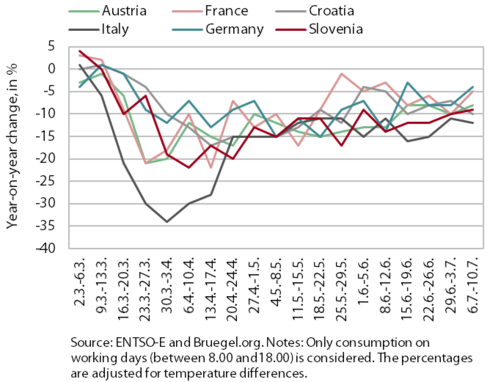
The year-on-year decline in weekly electricity consumption decreased somewhat again in the second week of July. In the first week of July, weekly electricity consumption was 10% lower year on year (in June, by around 12% lower on average), while in the second week the decline decreased to 9%. In the second week, the year-on-year decline also decreased relative to the first week in the majority of our main trading partners (the most in France and Germany), while it increased in Italy and Croatia.
Traffic of electronically tolled vehicles on Slovenian motorways, July 2020
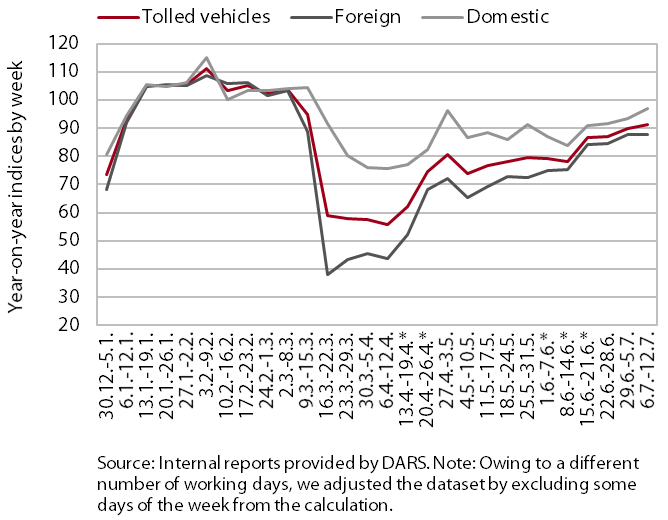
In the second week of July, freight traffic on Slovenian motorways was only somewhat less than a tenth lower than before the epidemic. A more than 40% decline after the declaring of the epidemic was followed by an improvement in April and stagnation in May. Since mid-June traffic has again been rising; in the second week of July it was around 9% lower year on year. The distance travelled by domestic and foreign trucks declined by 3% and 12% respectively.
Labour market, May – June 2020
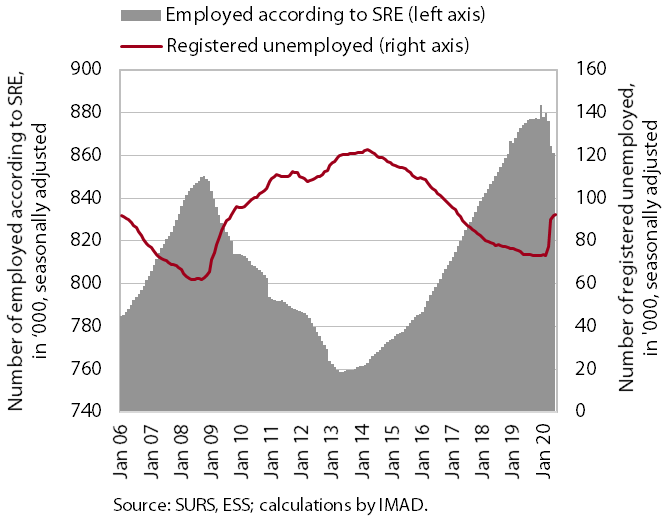
Employment declined further in May; the number of unemployed fell somewhat in June. The number of employed persons was by 1.5% lower year on year in May (in April by 1%). In both months the decline was the largest in accommodation and food service activities and administrative and support service activities (around 10%). A total of 89,377 persons were unemployed at the end of June, which is 1.1% less than at the end of May. We estimate that the decline in May reflects the lifting of stringent containment measures in Slovenia and neighbouring countries and the adoption of the third legislative package of measures to mitigate the economic impact of the crisis. Year on year, the number of unemployed persons was up 26.3%.
Wages, May 2020
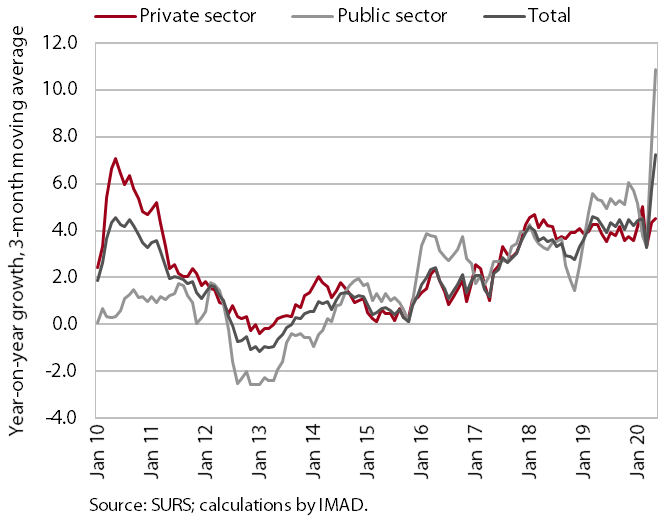
The year-on-year growth of the average wage remained high in May (9.5%). In the private sector, the pronounced year-on-year growth of wages in April and May (7.5 % on average) was to a great extent a consequence of the methodology, according to which employers report only the number of persons who receive wages and the amount of wages that is funded from their own resources (and not the amount of wage compensation paid by the government). Many employed persons being temporarily laid off, the amount of wages paid from employers’ resources decreased significantly in April and May compared with the beginning of the year. The number of employed persons who received wages funded by employers declined even more, which was reflected in the growth of the average gross wage. However, both the amount of wages and the number of workers were already somewhat higher in May compared with April. In the public sector, the methodological effect of temporary layoffs was significantly smaller. The stronger wage growth in April and May (14.5%) was attributable to the payment of allowances for hazardous working conditions and additional workloads and the payment of the bonus for work in crisis conditions (according to the collective agreement).
Construction, May 2020
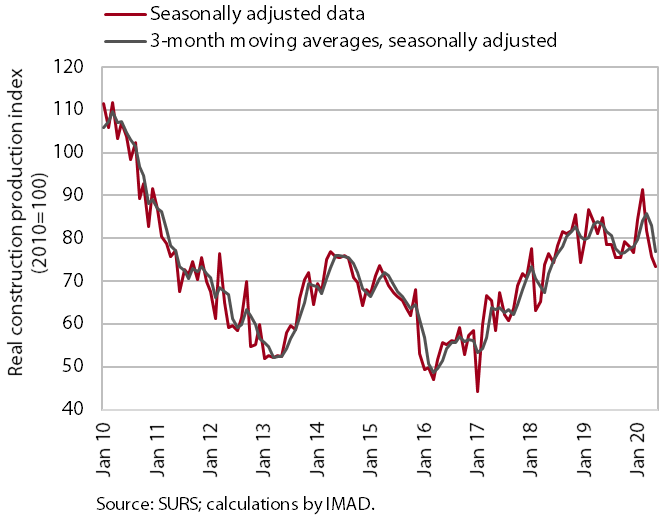
In May, construction activity declined further. Relative to February, the last month before the outbreak of the epidemic, activity declined by 19.5%, the most in the construction of non-residential buildings (29.3%), followed by the construction of civil-engineering works (21.2%), and the least in the construction of residential buildings (1.8%).
The stock of contracts remained high in May. It was around 10% higher than in the same period of last year. A somewhat worse picture is indicated by data on issued construction permits, which declined significantly this year, and by business trends in construction, which otherwise improved in June but remained markedly lower than before the outbreak of the epidemic.
Slovenian industrial producer prices, June 2020
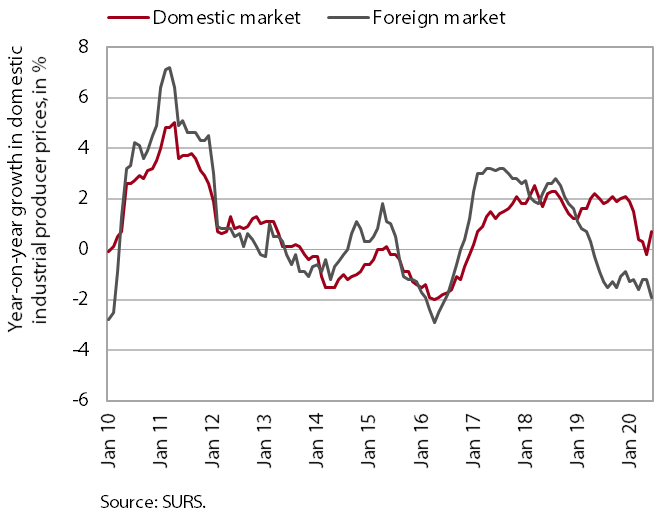
Slovenian industrial producer prices remained lower year on year in June (by 0.6%). On the domestic market, producer prices otherwise increased due to the expiry of the government measure on a temporary reduction of electricity prices and higher growth in prices of investment goods (2.9%). In contrast, a stronger decline in prices of investment goods was the main reason for a more pronounced moderation of growth in producer prices on foreign markets, which were thus almost 2% lower year on year.
Current account of the balance of payments, May 2020
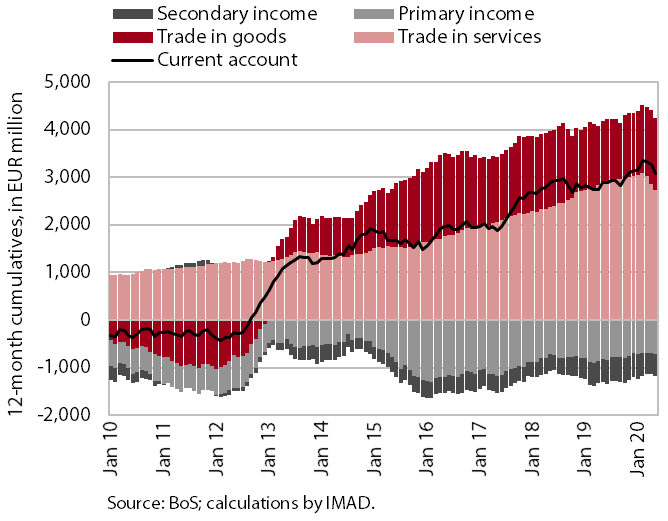
The measures to contain the epidemic are mainly reflected in the segment of external trade in goods and services and in primary income. The current account surplus declined again in May. The year-on-year decline in the surplus in current transactions arose mainly from a lower surplus in trade in services. The strong fall in the trade and surplus in travel services continued (exports and imports of travel services accounted for only 7% of those in May 2019); the trade and surplus in transport services also fell significantly. The surplus in goods trade was also lower year on year in May, due to a larger fall in imports than exports (which is also related to a larger decline in import prices, energy prices in particular). The deficit in primary income was higher year on year in May, largely due to a smaller surplus in labour income. The surplus of the current account of the balance of payments totalled EUR 3.1 billion (6.8% of estimated GDP).
Road and rail freight transport, Q1 2020
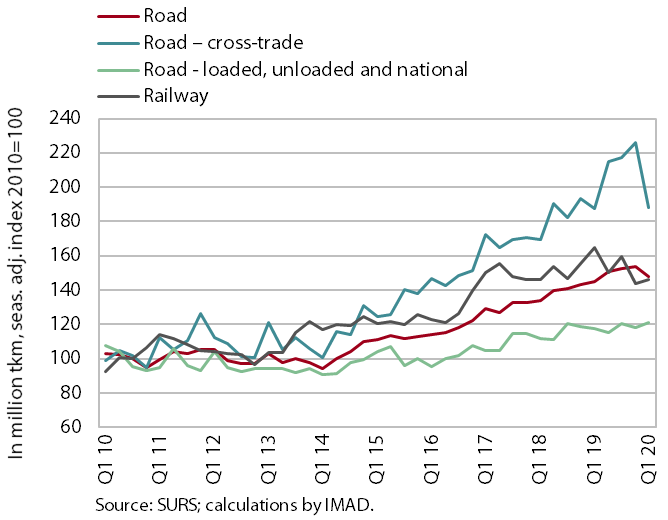
Road freight transport declined with the outbreak of the epidemic in the first quarter of 2020; rail transport remained low. As a result of the declaration of the epidemic in Slovenia and other European countries (in March) and related border restrictions, the volume of road transport performed by Slovenian hauliers abroad declined the most at the quarterly level, by a sixth. The volume of road transport that is at least partially connected to the territory of Slovenia (exports, imports and national transport together) increased further (almost by 3%). After a strong decline in the last quarter of 2019, the volume of rail transport was among the lowest in the last three years.
